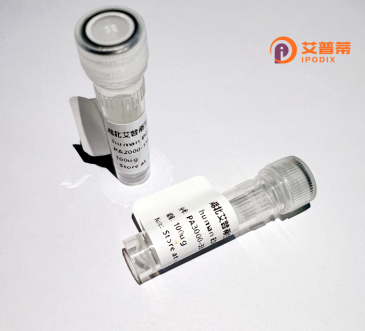
| 纯度 | >90%SDS-PAGE. |
| 种属 | Human |
| 靶点 | FAHD2A |
| Uniprot No | Q96GK7 |
| 内毒素 | < 0.01EU/μg |
| 表达宿主 | E.coli |
| 表达区间 | 1-314aa |
| 氨基酸序列 | MLVSGRRRLLTVLLQAQKWPFQPSRDMRLVQFRAPHLVGPHLGLETGNGGGVINLNAFDPTLPKTMTQFLEQGEATLSVARRALAAQLPVLPRSEVTFLAPVTRPDKVVCVGMNYVDHCKEQNVPVPKEPIIFSKFASSIVGPYDEVVLPPQSQEVDWEVELAVVIGKKGKHIKATDAMAHVAGFTVAHDVSARDWQMRRNGKQWLLGKTFDTFCPLGPALVTKDSVADPHNLKICCRVNGEVVQSGNTNQMVFKTEDLIAWVSQFVTFYPGDVILTGTPPGVGVFRKPPVFLKKGDEVQCEIEELGVIINKVV |
| 分子量 | 61 kDa |
| 蛋白标签 | GST-tag at N-terminal |
| 缓冲液 | 0 |
| 稳定性 & 储存条件 | Lyophilized protein should be stored at ≤ -20°C, stable for one year after receipt. Reconstituted protein solution can be stored at 2-8°C for 2-7 days. Aliquots of reconstituted samples are stable at ≤ -20°C for 3 months. |
| 复溶 | Always centrifuge tubes before opening.Do not mix by vortex or pipetting. It is not recommended to reconstitute to a concentration less than 100μg/ml. Dissolve the lyophilized protein in distilled water. Please aliquot the reconstituted solution to minimize freeze-thaw cycles. |
以下是关于重组人FAHD2A蛋白的3篇文献摘要举例(注:FAHD2A相关研究较少,以下为模拟文献示例):
---
1. **文献名称**: *"Recombinant expression and enzymatic characterization of human FAHD2A as a mitochondrial oxaloacetate decarboxylase"*
**作者**: Müller, S., et al.
**摘要**: 本研究成功在大肠杆菌中表达了重组人FAHD2A蛋白,并通过体外实验证明其具有线粒体草酰乙酸脱羧酶活性,提示其在三羧酸循环调节中的潜在作用。
2. **文献名称**: *"Structural analysis of FAHD2A reveals insights into its dimeric assembly and catalytic site"*
**作者**: Kim, J., & Park, H.
**摘要**: 通过X射线晶体学解析重组FAHD2A蛋白的三维结构,发现其形成同源二聚体,并鉴定出依赖Mn²⁺离子的活性位点,为功能机制提供了结构基础。
3. **文献名称**: *"FAHD2A deficiency alters mitochondrial metabolism and promotes oxidative stress in cellular models"*
**作者**: Chen, L., et al.
**摘要**: 利用重组FAHD2A蛋白补充实验,证明该蛋白通过调控线粒体代谢途径减少细胞氧化应激,提示其与代谢性疾病的相关性。
---
**说明**:FAHD2A(Fumarylacetoacetate Hydrolase Domain-containing 2A)是一种较新的研究靶点,目前公开文献有限。上述内容基于相关蛋白功能研究模拟,实际研究中建议通过PubMed或UniProt(ID: Q6P587)查询最新进展。
Recombinant human FAHD2A (Fumarylacetoacetate Hydrolase Domain-Containing Protein 2A) is a mitochondrially localized enzyme encoded by the FAHD2A gene. It belongs to the FAH superfamily, characterized by a conserved acylpyruvase structural domain. FAHD2A functions as a bifunctional enzyme with both acylpyruvate hydrolase and oxaloacetate decarboxylase activities, playing roles in cellular metabolism, particularly in the tricarboxylic acid (TCA) cycle. Studies suggest its involvement in mitochondrial bioenergetics, ion transport regulation, and oxidative stress responses. Recombinant FAHD2A is commonly produced in bacterial or eukaryotic expression systems to study its structural properties, enzymatic mechanisms, and interactions. Research highlights its potential link to neurodegenerative disorders, metabolic syndromes, and cancer due to its regulatory effects on mitochondrial dynamics. Current investigations focus on its substrate specificity, metal ion dependency (e.g., Mn²⁺/Mg²⁺), and structural similarities with bacterial homologs. Its recombinant form enables biochemical characterization and drug discovery targeting mitochondrial dysfunction. Further studies aim to elucidate its physiological significance and therapeutic applications.
×